Charles E W Bean, Diaries, AWM38 3DRL 606/249/1 - 1917 - 1932 - Part 16

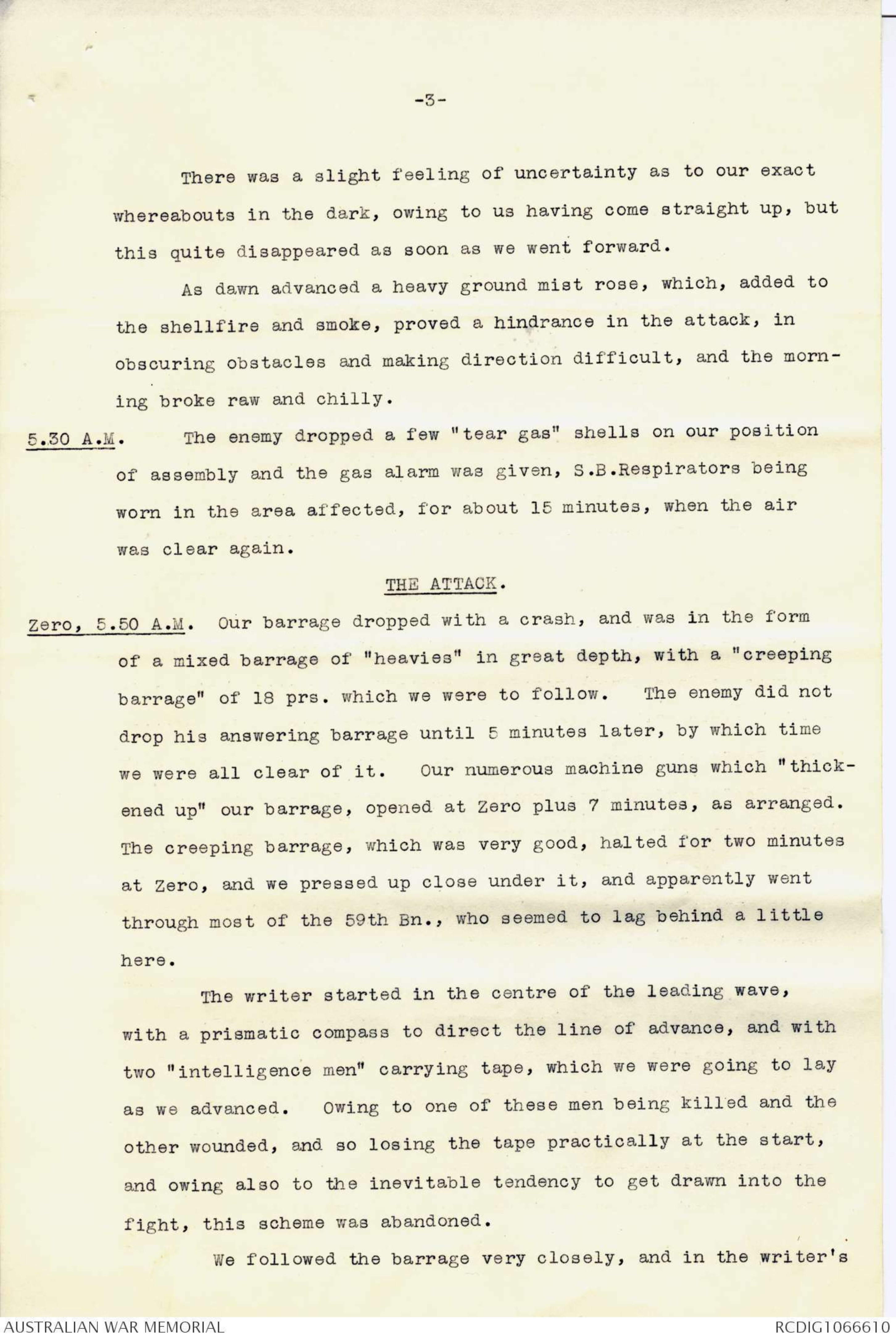
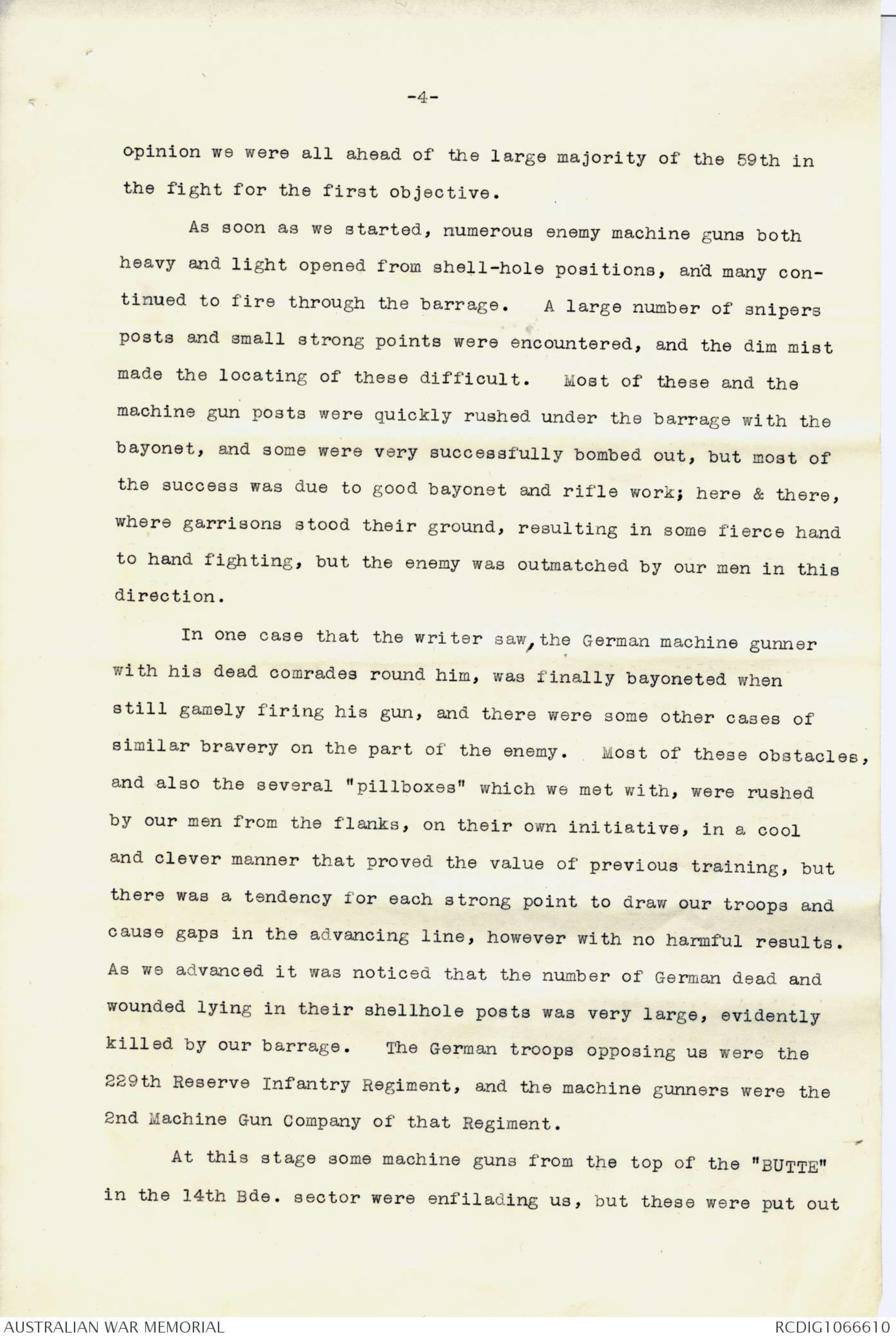
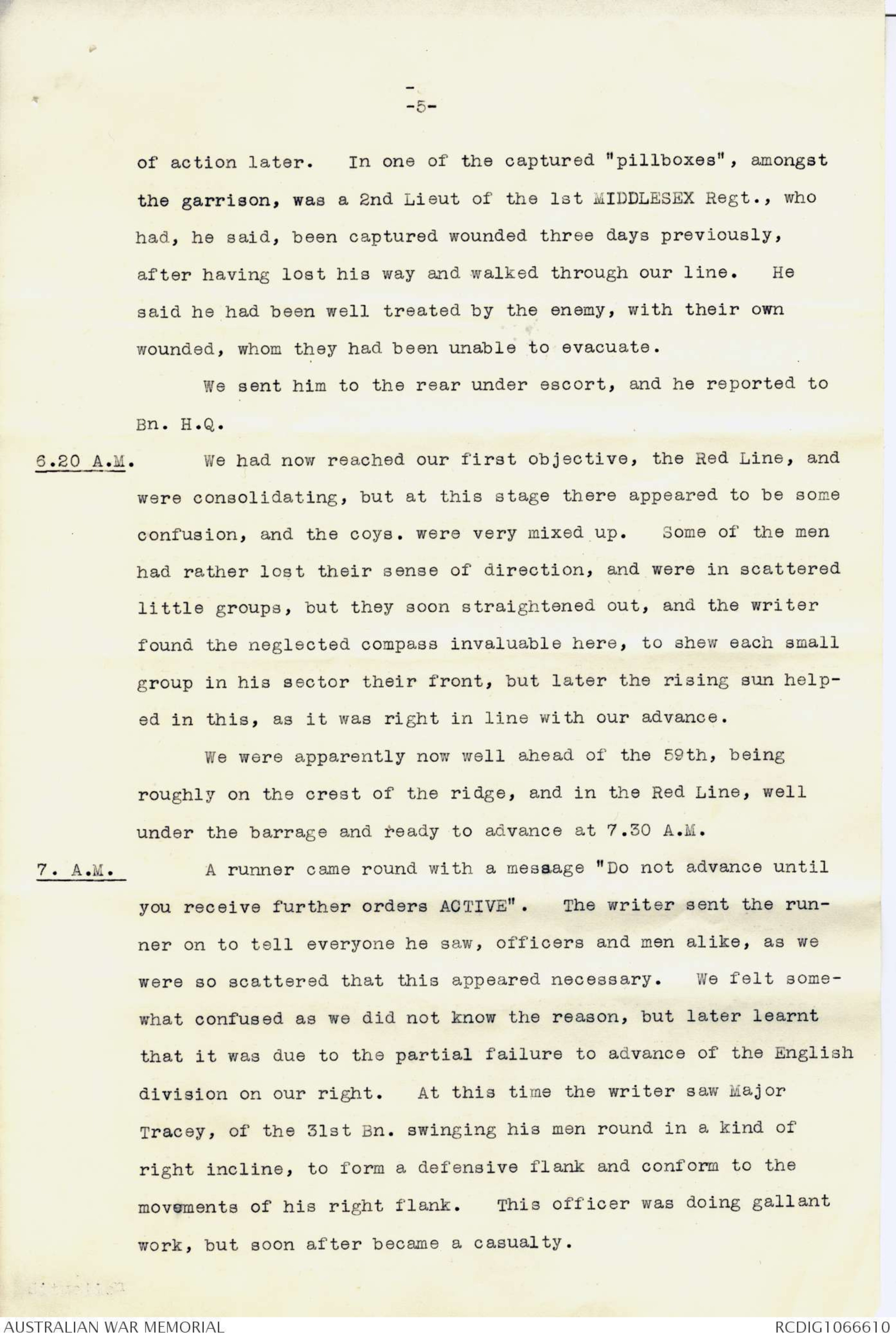
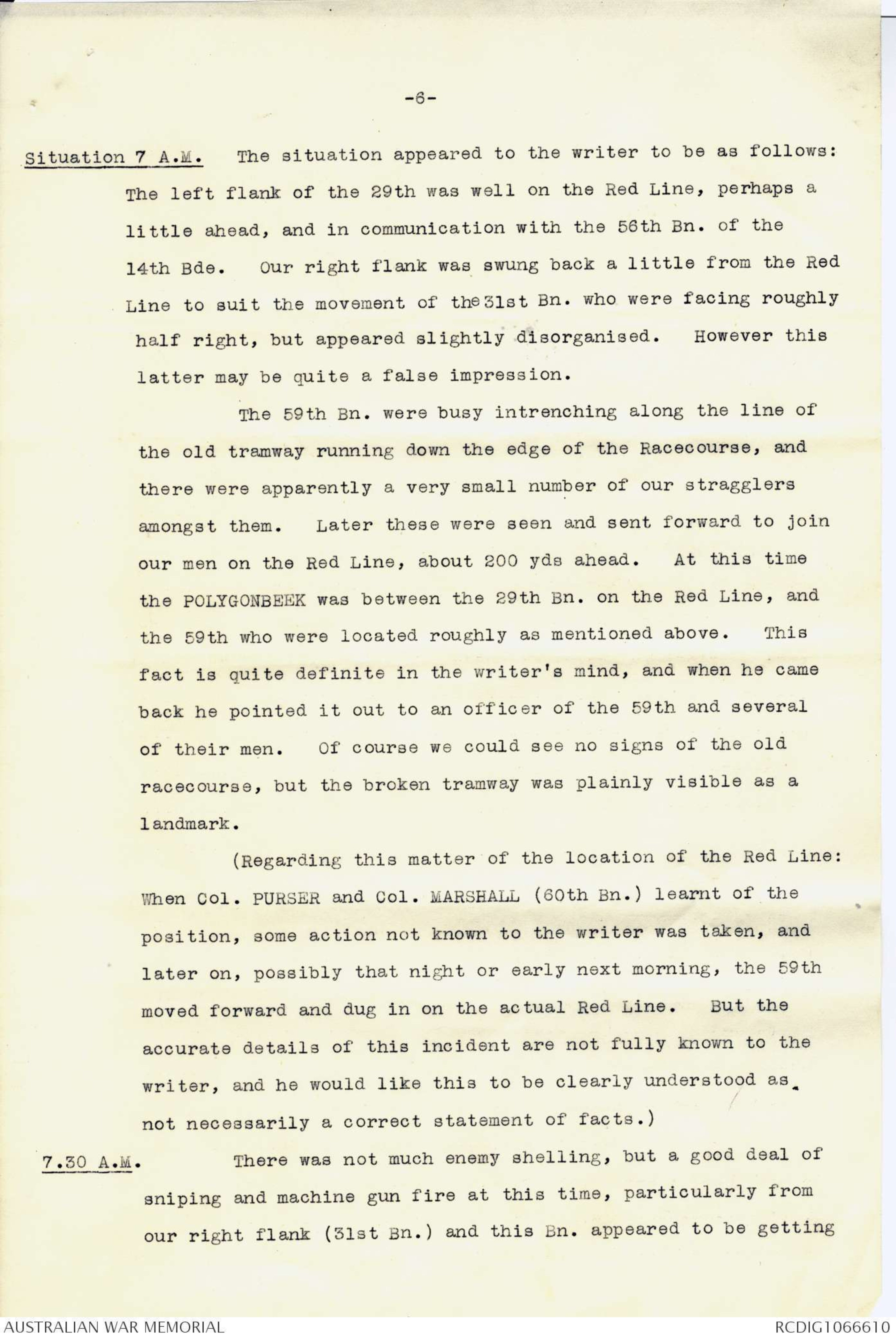
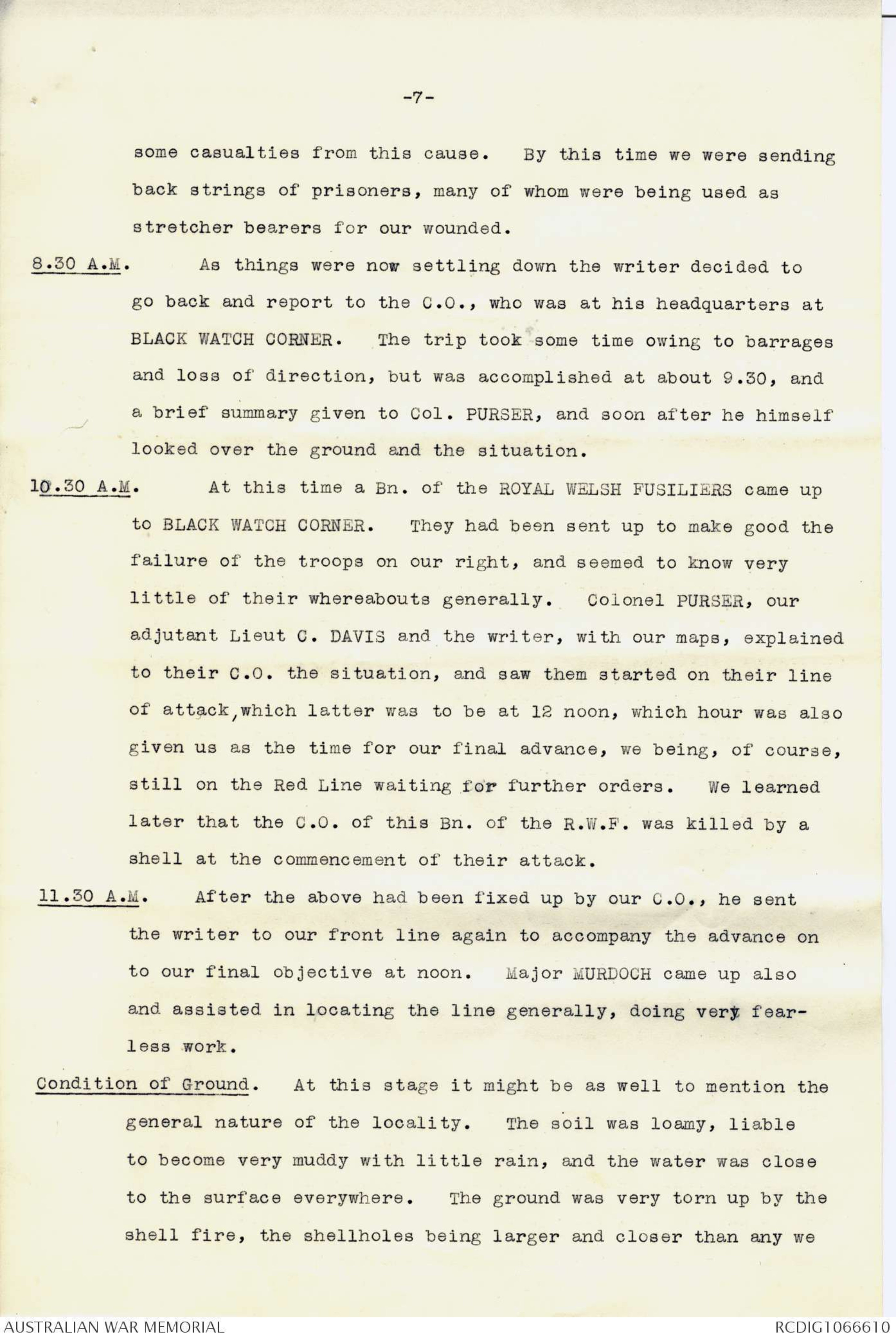
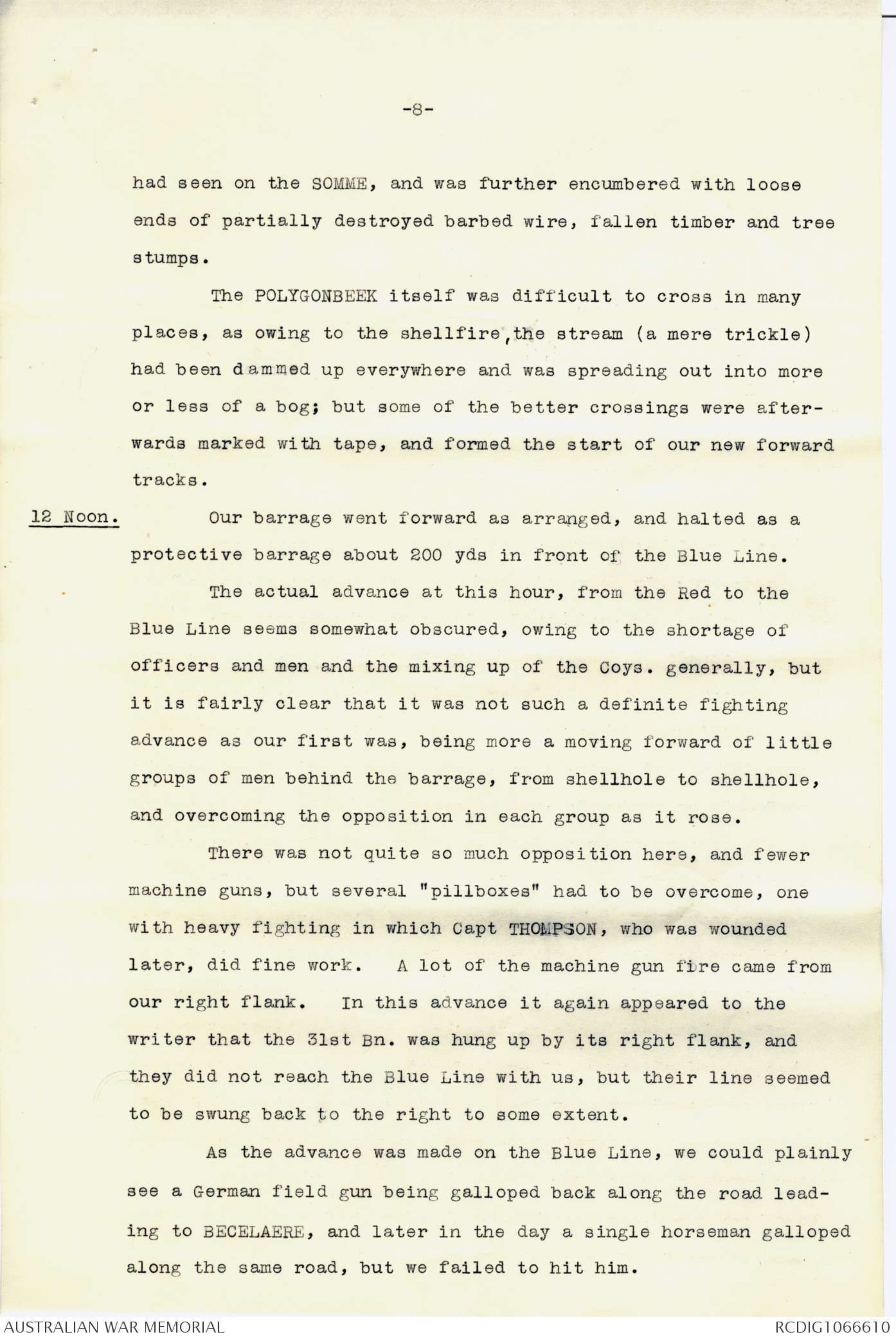

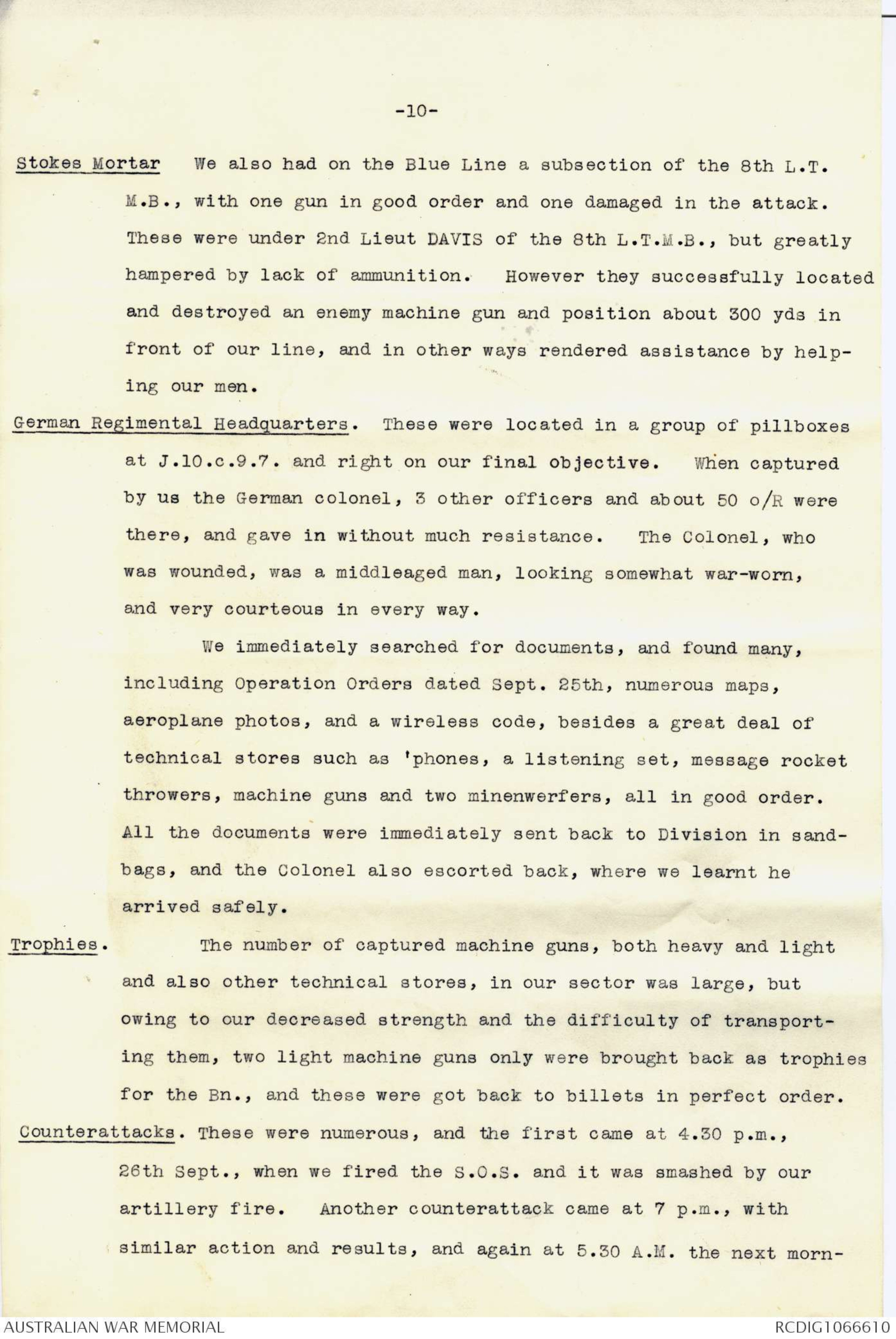
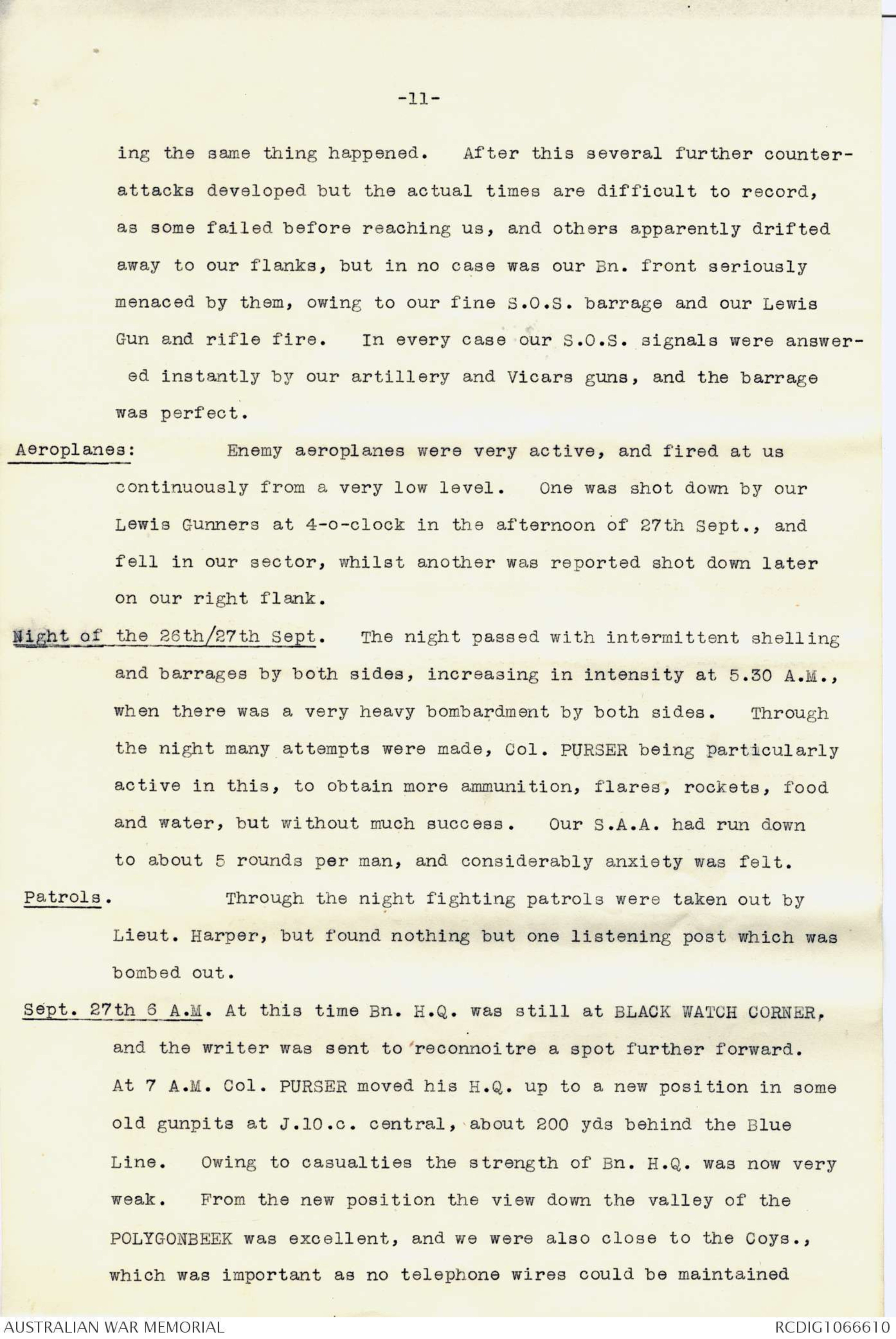
-2-
reconnoitred, to HALFWAY HOUSE. Here orders were received to
proceed, and after some delay we moved on with guides supplied
by the 15th Bde., passing by HOOGE CRATER, along the MENIN ROAD,
and so to BLACK WATCH CORNER, passing through an enemy H.E.
barrage on the way up. We arrived here at about 3 A M, 26th
Sept., and then moved on to our sector, and the Coys, were formed
up on tapes laid in readiness by the 15th Bde., our sector being
opposite the "Racecourse" in the centre of POLYGON WOOD, as shewn
on the map. The assembly took some little time, as other units
were also forming up, but finally all was correct at 5.10 A.M.,
and we sat down waiting for "Zero".
4. Formation. The Bn. was formed up behind the 59th, on a front of about
280 yds, with "B" Coy. in the lead, then "A" Coy.; "C" Coy., and
"D" Coy. in rear in support, the formation being as previously
practised, i.e., a line of "beaters" at about 6 yds interval,
then small fighting columns of men, then the "moppers up", followed
by the supporting Coys., in their prescribed formation. Capt
J. V. HOULIHAN was in command of "B" Coy; Capt BENNETT of "A";
Capt THOMPSON of "C": and Capt GCATE of D. All these officers,
except the latter, and all the Coy, subalterns save one, became
casualties in the attack.
All the coys, were formed up close to one another in depth,
and the men moved to their places as tho' on a "practise stunt",
quietly and without confusion, each man knowing exactly his job,
and all in a cheerful and confident mood.
The enemy was fairly quiet, except for sniping and scattered
machine gun fire, but he fired flares continuously, evidently
from positions very close to us, as the flares mostly dropped in
our ranks, and we had considerable difficulty in avoiding being
hit by them.
-3-
There was a slight feeling of uncertainty as to our exact
whereabouts in the dark, owing to us having come straight up, but
this quite disappeared as soon as we went forward.
As dawn advanced a heavy ground mist rose, which, added to
the shellfire and smoke, proved a hindrance in the attack, in
obscuring obstacles and making direction difficult, and the morning
broke raw and chilly.
5.30 A.M. The enemy dropped a few "tear gas" shells on our position
of assembly and the gas alarm was given, S.B.Respirators being
worn in the area affected, for about 15 minutes, when the air
was clear again.
THE ATTACK.
Zero, 5.50 A.M. Our barrage dropped with a crash, and was in the form
of a mixed barrage of "heavies" in great depth, with a "creeping
barrage" of 18 prs. which we were to follow. The enemy did not
drop his answering barrage until 5 minutes later, by which time
we were all clear of it. Our numerous machine guns which "thickened
up" our barrage, opened at Zero plus 7 minutes, as arranged.
The creeping barrage, which was very good, halted for two minutes
at Zero, and we pressed up close under it, and apparently went
through most of the 59th Bn., who seemed to lag behind a little
here.
The writer started in the centre of the leading wave,
with a prismatic compass to direct the line of advance, and with
two "intelligence men" carrying tape, which we were going to lay
as we advanced. Owing to one of these men being killed and the
other wounded, and so losing the tape practically at the start,
and owing also to the inevitable tendency to get drawn into the
fight, this scheme was abandoned.
We followed the barrage very closely, and in the writer's
-4-
opinion we were all ahead of the large majority of the 59th in
the fight for the first objective.
As soon as we started, numerous enemy machine guns both
heavy and light opened from shell-hole positions, and many continued
to fire through the barrage. A large number of snipers
posts and small strong points were encountered, and the dim mist
made the locating of these difficult. Most of these and the
machine gun posts were quickly rushed under the barrage with the
bayonet, and some were very successfully bombed out, but most of
the success was due to good bayonet and rifle work; here & there,
where garrisons stood their ground, resulting in some fierce hand
to hand fighting, but the enemy was outmatched by our men in this
direction.
In one case that the writer saw, the German machine gunner
with his dead comrades round him, was finally bayoneted when
still gamely firing his gun, and there were some other cases of
similar bravery on the part of the enemy. Most of these obstacles,
and also the several "pillboxes" which we met with, were rushed
by our men from the flanks, on their own initiative, in a cool
and clever manner that proved the value of previous training, but
there was a tendency for each strong point to draw our troops and
cause gaps in the advancing line, however with no harmful results.
As we advanced it was noticed that the number of German dead and
wounded lying in their shellhole posts was very large, evidently
killed by our barrage. The German troops opposing us were the
229th Reserve Infantry Regiment, and the machine gunners were the
2nd Machine Gun Company of that Regiment.
At this stage some machine guns from the top of the "BUTTE"
in the 14th Bde sector were enfilading us, but these were put out
-5-
of action later. In one of the captured "pillboxes", amongst
the garrison, was a 2nd Lieut of the 1st MIDDLESEX Regt., who
had, he said, been captured wounded three days previously,
after having lost his way and walked through our line. He
said he had been well treated by the enemy, with their own
wounded, whom they had been unable to evacuate.
We sent him to the rear under escort, and he reported to
Bn. H.Q.
6.20 A.M. We had now reached our first objective, the Red Line, and
were consolidating, but at this stage there appeared to be some
confusion, and the coys. were very mixed up. Some of the men
had rather lost their sense of direction, and were in scattered
little groups, but they soon straightened out, and the writer
found the neglected compass invaluable here, to shew each small
group in his sector their front, but later the rising sun helped
in this, as it was right in line with our advance.
We were apparently now well ahead of the 59th. being
roughly on the crest of the ridge, and in the Red Line, well
under the barrage and ready to advance at 7.30 A.M.
7. A.M. A runner came round with a message "Do not advance until
you receive further orders ACTIVE". The writer sent the runner
on to tell everyone he saw, officers and men alike, as we
were so scattered that this appeared necessary. We felt somewhat
confused as we did not know the reason, but later learnt
that it was due to the partial failure to advance of the English
division on our right. At this time the writer saw Major
Tracey, of the 31st Bn. swinging his men round in a kind of
right incline, to form a defensive flank and conform to the
movements of his right flank. This officer was doing gallant
work, but soon after became a casualty.
-6-
Situation 7 A.M. The situation appeared to the writer to be as follows:
The left flank of the 29th was well on the Red Line, perhaps a
little ahead, and in communication with the 56th Bn. of the
14th Bde. Our right flank was swung back a little from the Red
Line to suit the movement of the3lst Bn. who were facing roughly
half right, but appeared slightly disorganised. However this
latter may be quite a false impression.
The 59th Bn. were busy intrenching along the line of
the old tramway running down the edge of the Racecourse, and
there were apparently a very small number of our stragglers
amongst them. Later these were seen and sent forward to join
our men on the Red Line, about 200 yds ahead. At this time
the POLYGONBEEK was between the 29th Bn. on the Red Line, and
the 59th who were located roughly as mentioned above. This
fact is quite definite in the writer's mind, and when he came
back he pointed it out to an officer of the 59th and several
of their men. Of course we could see no signs of the old
racecourse, but the broken tramway was plainly visible as a
landmark.
(Regarding this matter of the location of the Red Line:
When Col. PURSER and Col. MARSHALL (60th Bn.) learnt of the
position, some action not known to the writer was taken, and
later on, possibly that night or early next morning, the 59th
moved forward and dug in on the actual Red Line. But the
accurate details of this incident are not fully known to the
writer, and he would like this to be clearly understood as
not necessarily a correct statement of facts.)
7.30 A.M. There was not much enemy shelling, but a good deal of
sniping and machine gun fire at this time, particularly from
our right flank (31st Bn.) and this Bn. appeared to be getting
-7-
some casualties from this cause. By this time we were sending
back strings of prisoners, many of whom were being used as
stretcher bearers for our wounded.
8.30 A.M As things were now settling down the writer decided to
go back and report to the C.O., who was at his headquarters at
BLACK WATCH CORNER. The trip took some time owing to barrages
and loss of direction, but was accomplished at about 9.30, and
a brief summary given to Col. PURSER, and soon after he himself
looked over the ground and the situation.
10.30 A.M. At this time a Bn. of the ROYAL WELSH FUSILIERS came up
to BLACK WATCH CORNER. They had been sent up to make good the
failure of the troops on our right, and seemed to know very
little of their whereabouts generally. Colonel PURSER, our
adjutant Lieut C. DAVIS and the writer, with our maps, explained
to their C.O. the situation, and saw them started on their line
of attack, which latter was to be at 12 noon, which hour was also
given us as the time for our final advance, we being, of course,
still on the Red Line waiting for further orders. We learned
later that the C.O. of this Bn, of the R.W.F. was killed by a
shell at the commencement of their attack.
11.30 A.M. After the above had been fixed up by our C.O., he sent
the writer to our front line again to accompany the advance on
to our final objective at noon. Major MURDOCH came up also
and assisted in locating the line generally, doing very fearless
work.
Condition of Ground. At this stage it might be as well to mention the
general nature of the locality. The soil was loamy, liable
to become very muddy with little rain, and the water was close
to the surface everywhere. The ground was very torn up by the
shell fire, the shellholes being larger and closer than any we
-8-
had seen on the SOMME, and was further encumbered with loose
ends of partially destroyed barbed wire, fallen timber and tree
stumps.
The POLYGONBEEK itself was difficult to cross in many
places, as owing to the shellfire, the stream (a mere trickle)
had been dammed up everywhere and was spreading out into more
or less of a bog; but some of the better crossings were afterwards
marked with tape, and formed the start of our new forward
tracks.
12 Noon. Our barrage went forward as arranged, and halted as a
protective barrage about 200 yds in front of the Blue Line.
The actual advance at this hour, from the Red to the
Blue Line seems somewhat obscured, owing to the shortage of
officers and men and the mixing up of the Coys. generally, but
it is fairly clear that it was not such a definite fighting
advance as our first was, being more a moving forward of little
groups of men behind the barrage, from shellhole to shellhole,
and overcoming the opposition in each group as it rose.
There was not quite so much opposition here, and fewer
machine guns, but several "pillboxes" had to be overcome, one
with heavy fighting in which Capt THOMPSON, who was wounded
later, did fine work. A lot of the machine gun fire came from
our right flank. In this advance it again appeared to the
writer that the 31st Bn. was hung up by its right flank, and
they did not reach the Blue Line with us, but their line seemed
to be swung back to the right to some extent.
As the advance was made on the Blue Line, we could plainly
see a German field gun being galloped back along the road leading
to BECELAERE, and later in the day a single horseman galloped
along the same road, but we failed to hit him.
-9-
THE CONSOLIDATION.
1.30 P.M. Sept. 26th. Our Bn. was by this time practically
on the Blue Line everywhere and ground flares were lit when
called for by our contact aeroplanes. The men were all busy
consolidating shellholes, in depth, and somewhere about this
time word was sent back to the 15th Bde. to this effect. When
some definite line could be seen, and a location decided, the
position was as follows, as seen by the writer and confirmed
by information gained and bearings taken on prominent landmarks.
2 p.m. General Situation, Blue Line. Our left flank was in JETTY TRENCH,
swung out slightly and coinciding with the Barrage Map, in touch
with the 56th Bn., and consolidated in shellholes and the remains
of the trench. JETTY TRENCH itself was not visible,
nor was the wire, except for loose ends and scraps.
The POLYGONBEEK divided the Bn. front roughly in half,
and this left half was under the command of Lieut G. HARPER,
of "B" Coy., whose solid work throughout the operations has
been recorded elsewhere. He had no other officers, but some
N.C.O's, about 40 men, and 7 Lewis Guns, one of which was damaged.
These guns were all carefully sited, the position well
organised for defence and the men were very confident.
The remainder of the Blue Line was from POLYGONBEEK to
about 200 yds south, and included a group of concrete "pillboxes"
which had been a German regimental H.Q. when we captured it,
This portion of the line was under Capt CATE, who had the situation
well in hand. He had no other officers left, but
several N.C.O's and about 80 men and some Lewis Guns, but these
figures for the strengths are very difficult to confirm accurately.
Consolidation was also going on here, and the position
good for defence.
-10-
Stokes Mortar. We also had on the Blue Line a subsection of the 8th L.T.
M.B., with one gun in good order and one damaged in the attack.
These were under 2nd Lieut DAVIS of the 8th L.T.M.B., but greatly
hampered by lack of ammunition. However they successfully located
and destroyed an enemy machine gun and position about 300 yds in
front of our line, and in other ways rendered assistance by helping
our men.
German Regimental Headquarters. These were located in a group of pillboxes
at J.10.c.9.7. and right on our final objective. When captured
by us the German colonel, 3 other officers and about 50 o/R were
there, and gave in without much resistance. The Colonel, who
was wounded, was a middleaged man, looking somewhat war-worn,
and very courteous in every way.
We immediately searched for documents, and found many,
including Operation Orders dated Sept. 25th, numerous maps,
aeroplane photos, and a wireless code, besides a great deal of
technical stores such as 'phones, a listening set, message rocket
throwers, machine guns and two minenwerfers, all in good order.
All the documents were immediately sent back to Division in sand-bags,
and the Colonel also escorted back, where we learnt he
arrived safely.
Trophies. The number of captured machine guns, both heavy and light
and also other technical stores, in our sector was large, but
owing to our decreased strength and the difficulty of transporting
them, two light machine guns only were brought back as trophies
for the Bn., and these were got back to billets in perfect order.
Counterattacks. These were numerous, and the first came at 4.30 p.m.,
26th Sept., when we fired the S.O.S. and it was smashed by our
artillery fire. Another counterattack came at 7 p.m., with
similar action and results, and again at 5.30 A.M. the next morning
-11-
the same thing happened. After this several further counter-attacks
developed but the actual times are difficult to record,
as some failed before reaching us, and others apparently drifted
away to our flanks, but in no case was our Bn. front seriously
menaced by them, owing to our fine S.O.S. barrage and our Lewis
Gun and rifle fire. In every case our S.O.S. signals were answered
instantly by our artillery and Vicars guns, and the barrage
was perfect.
Aeroplanes: Enemy aeroplanes were very active, and fired at us
continuously from a very low level. One was shot down by our
Lewis Gunners at 4-o-clock in the afternoon of 27th Sept., and
fell in our sector, whilst another was reported shot down later
on our right flank.
Night of the 26th/27th Sept. The night passed with intermittent shelling
and barrages by both sides, increasing in intensity at 5.30 A.M.,
when there was a very heavy bombardment by both sides. Through
the night many attempts were made, Col. PURSER being particularly
active in this, to obtain more ammunition, flares, rockets, food
and water, but without much success. Our S.A.A. had run down
to about 5 rounds per man, and considerably anxiety was felt.
Patrols. Through the night fighting patrols were taken out by
Lieut. Harper, but found nothing but one listening post which was
bombed out.
Sept. 27th 6 A.M. At this time Bn. H.Q. was still at BLACK WATCH CORNER,
and the writer was sent to reconnoitre a spot further forward.
At 7 A.M. Col. PURSER moved his H.Q. up to a new position in some
old gunpits at J.10.c. central, about 200 yds behind the Blue
Line. Owing to casualties the strength of Bn. H.Q. was now very
weak. From the new position the view down the valley of the
POLYGONBEEK was excellent, and we were also close to the Coys.,
which was important as no telephone wires could be maintained
 Sam scott
Sam scottThis transcription item is now locked to you for editing. To release the lock either Save your changes or Cancel.
This lock will be automatically released after 60 minutes of inactivity.